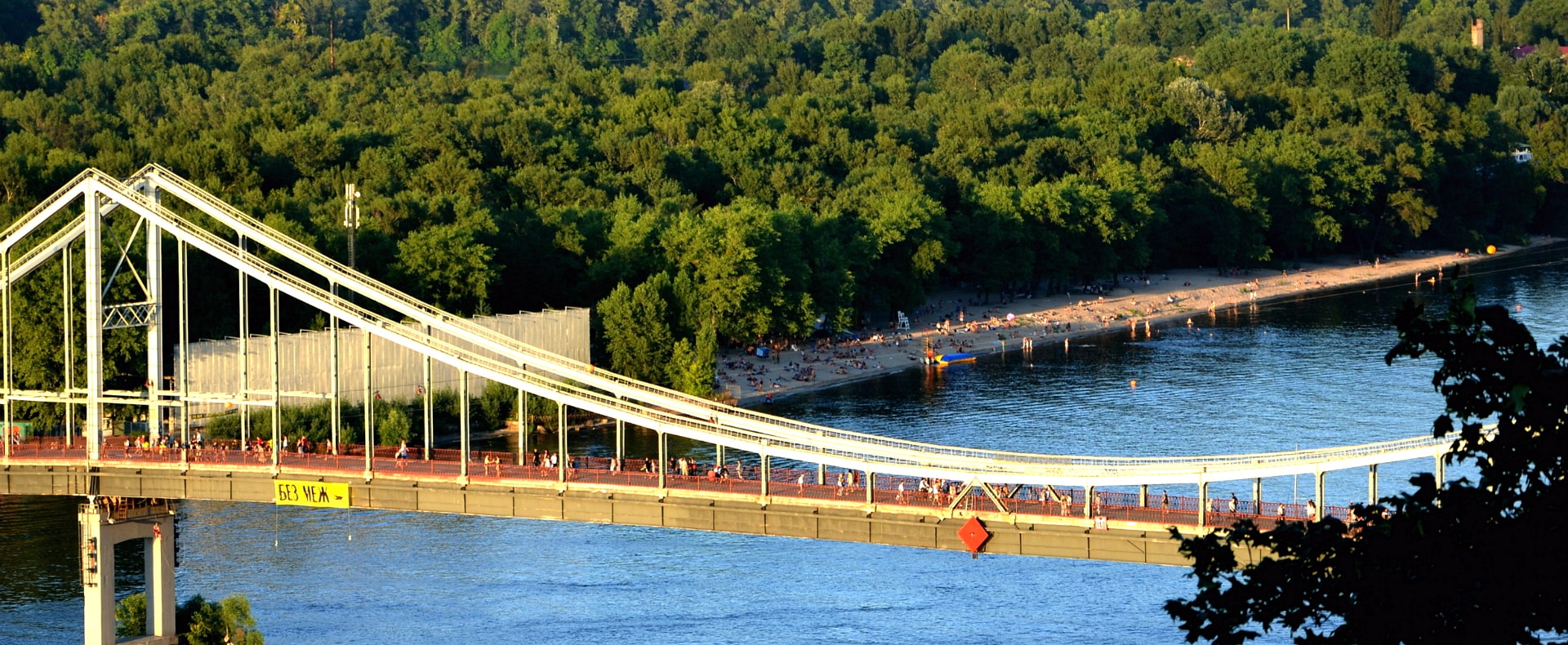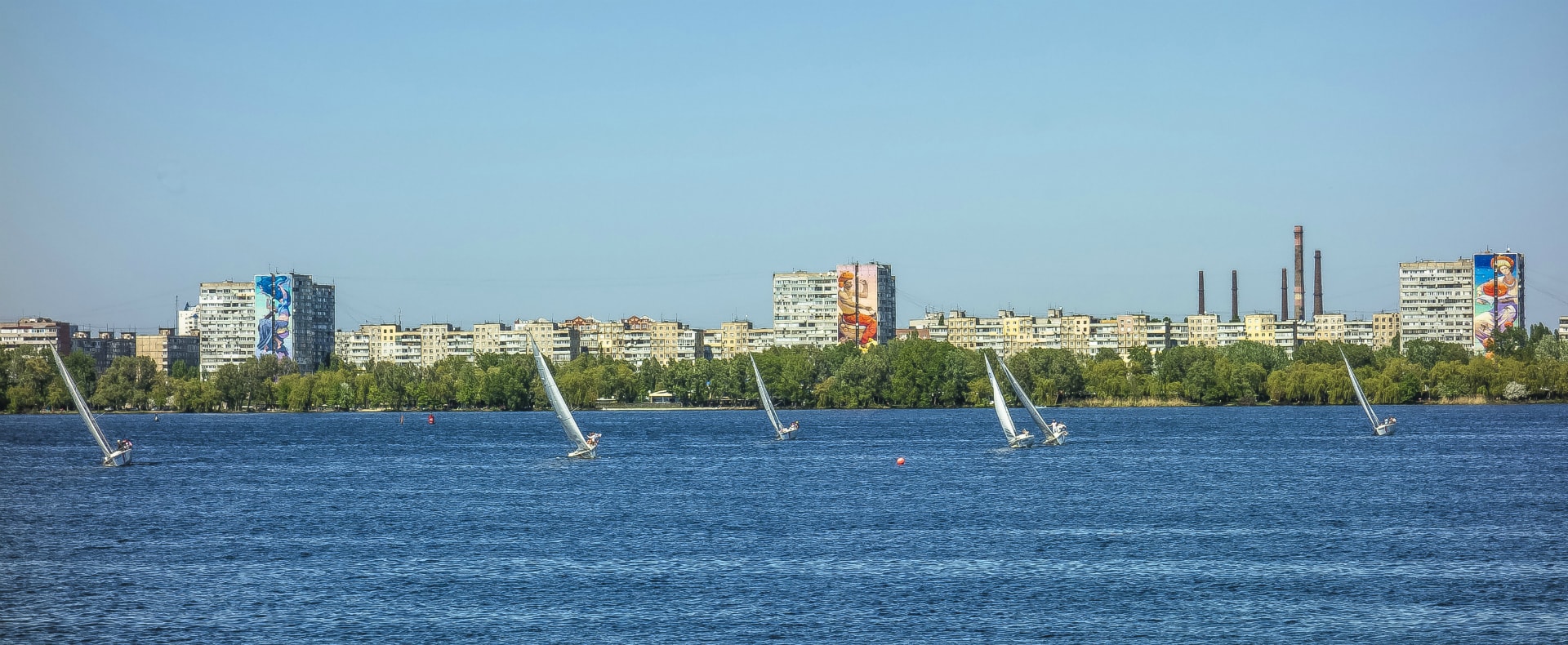The Dnieper and Ukraine are so inextricably tied that you couldn’t have one without the other. This wide river is navigable by ship from the Podil waterfront in Kiev down to the river’s mouth. As the Volga is the soul of Russia, the Dnieper (transliterated Dnipro in Ukrainian) is the essence of Ukraine.
A cruise ship that departs the Ukrainian capital from below one of the most beautiful churches in the world, the Cathedral of St. Andrew, passes the Friendship Arch and Founders of Kiev monument (both built in 1982), the eternal golden domes of the Kiev Pechersky Lavra (or “Caves Monastery”), and the Soviet-era iconic Rodina Mat, or Motherland Statue. Passengers share the perspective of these landmarks with the sunbathers of Hidropark, a popular island park that stretches out on the opposite bank of the channel through which the ship passes.
Why Explore the Dnieper River
On the way to the Black Sea, the ship passes five great dams that act as a staircase going up or down the river. Perhaps the United States' closest equivalent would be the dam system on the Columbia River in the Pacific Northwest. The first dam that ships reach when coming from Kiev is the Kaniv Dam, located near the city of the same name, the burial place of national poet Taras Shevchenko. Below it, ships generally stop at Cherkassy (Cherkasy in Ukrainian), the forest fortress city that once acted as a bulwark against raids made by the Crimean Tatars. The second dam is at Kremenchuk, near what was once a serious set of rapids on the river. The name came from the alert sounded by residents: “Kremen!”
Below this second dam, the boat reaches Dnepropetrovsk - the largest city on the river after Kiev. Built on the ancient rapids atop ruins, it is as ancient as the era of the Goths. For instance, the site of Bashmachka dates back to the 3rd century. The city was at one time to host one of the biggest churches in the world, one that would rival St. Peter’s Basilica in Rome, according to the plans of Prince Potemkin. Eventually, it settled for the Cathedral of the Transfiguration, a church designed similarly to the Morskaya Cathedral on Kronstadt near St. Petersburg. These references to St. Peter eventually led to its rather lengthy name “St. Peter’s on the Dnieper River”.
Below the Dnieper Dam, the ship reaches the next major stop just above the next dam. Both river port and dam are named Zaporozhye. This relatively modern city was, before the Russian Revolution, named Alexandrovsk. In 1921, it was renamed Zaporozhye, a name meaning “beyond the rapids.” However, it is sometimes seen as a commemoration of the Zaporizhian Sich, the great Cossack state that existed along the river below the 18th century. This so-called “Cossack republic” developed from the Hetmanate started by Bogdan Khmelnitsky in the mid-17th century. Eventually, the Tsarist authorities established firmer and firmer control of its client hetmans, resulting in the more independent members forming the independent Sich further south under what is today the Kakhovka Reservoir. The main fortress of the Sich was occupied and destroyed under orders of Catherine the Great in 1775.
Below the Kakhovka Dam, the lowest on the river, the ship pulls into Kherson's port. Renowned for its shipyards and for being the first major Russian port in which Catherine the Great was established on the Black Sea, Kherson was named for the ancient Greek city of Chersonesus, actually located on the Crimea. Having been created on Russia’s frontier during a time of expansion against the Turks, the city has a large number of military monuments and relics. However, there are also many nearby beaches to enjoy and the Askania-Nova wildlife preserve - home to many unique animals, including the largest population of Przewalski’s Horse, a breed native to Mongolia and the only horse species never to be fully domesticated.
After the cruise ship passes the shipyards on its way to the Dnieper River mouth, it enters the Dnieper Liman, the great river's estuary. At the very mouth of the Liman, on the right bank, is the ancient city of Ochakov. In the days of Peter the Great, this was the Turkish side of the frontier, and it was the place where King Charles of Sweden fled after losing almost his entire army in the Battle of Poltava. Today, the city is the seaside resort for the Mykolaivska Oblast and a major fishing port.
Once the ship passes on to the open sea, it can either go to Yalta - a beautiful Crimean town or port of the one-of-a-kind Odesa. Odesa today is, in fact, slightly smaller than Dnepropetrovsk but has served a much larger role in the annals of Ukraine. After becoming the main port of the Novorossiya region, a role it took from Kherson became a city rich with traders, sailors, and travelers of all kinds. The Porto Franco District in the city center still captures some of Odessa's essence in its Golden Age under the Tsars, with all manner of modern shopping available for tourists. The Potemkin Steps (the location of a major battle scene in Sergei Eisenstein’s film “The Battleship Potemkin”) lead between this area of the city and the coast not far from where the “Mother-in-Law Bridge” traverses a deep valley called the Military Descent.
This bridge’s nickname stems from the story of a party official named Mikhail Sinitsa, who had to deal with an unhappy mother-in-law in the 1960's. He would determinedly go down from her hill each day and back up to his place across this valley, arriving each day in a terrible mood. To make her mood more pleasant and, some say, more conducive to making bliny pancakes that he loved so much, he hired the architect Vladimirsky to have the bridge built. As with many bridges in the former Soviet countries, today it is adorned with “lovers’ locks,” padlocks set in place by newlyweds with the intention of “locking tight” their union with each other (the keys are afterward thrown off the bridge so that the lock never is opened again).
As any visitor would tell you, the spirit of Ukraine dwells in the Dnieper River. To understand it fully, climb aboard a ship for a cruise between Ukraine’s capital and the Black Sea. You will return home not only with new friends but with the experience of a lifetime.




